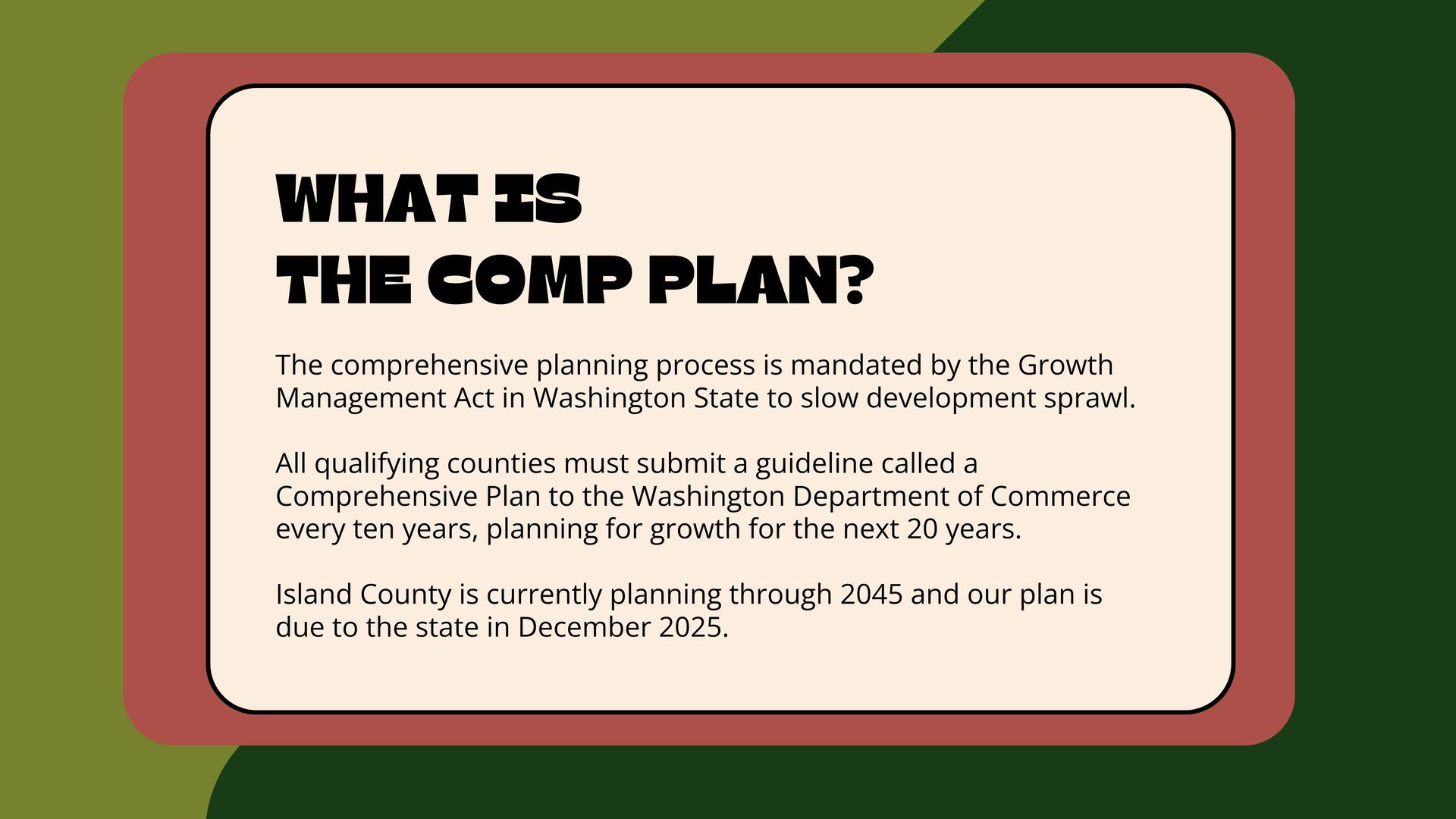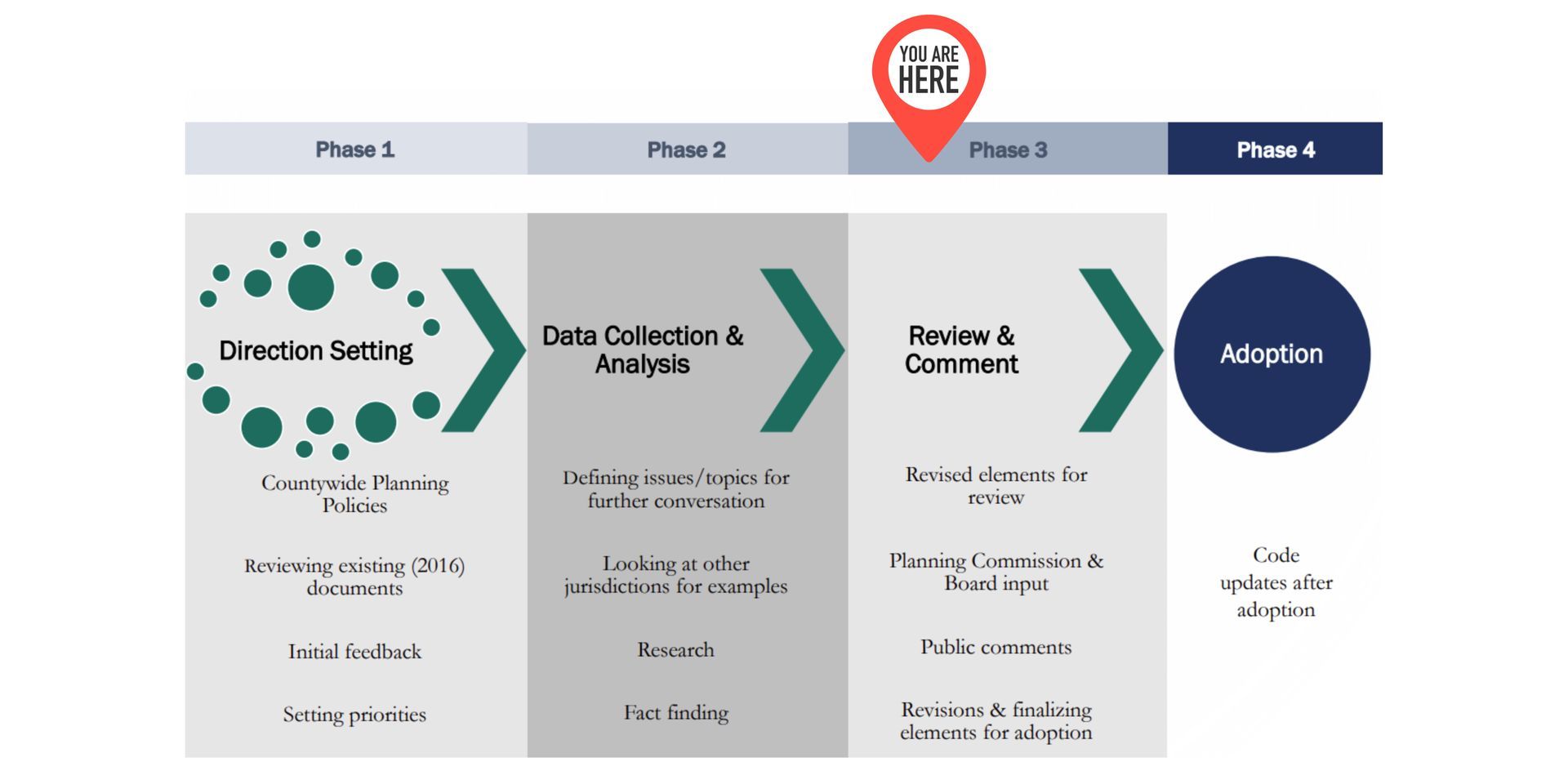What Is The Comprehensive Plan, Exactly?

A Quick Overview
In 1990, the Washington State legislature passed the Growth Management Act (GMA), a law designed to slow development sprawl in the state. The comprehensive planning process is mandated by the Growth Management Act, requiring all qualifying jurisdictions in Washington to plan strategically for population growth in areas that already have density while protecting rural areas and natural resources. Every county that qualifies must submit a guideline called a Comprehensive Plan to the Washington Department of Commerce every ten years, planning for population growth for the next 20 years.
Island County is a qualifying county, and is currently planning through 2045. This process is led by our Long Range Planners in the Department of Planning and Community Development. Our plan is due to the state in December 2025.
"The Planning Department’s overarching goal is to deliver a plan on schedule that meets the statutory requirements," Emily Neff told us in an interview via email last September. "The Board of Island County Commissioners have set three priorities for the comprehensive plan update: Equity, Health, and Climate Resilience."
What Are The Goals Of The Plan?
The Growth Management Act outlines 15 planning goals that it seeks to achieve through Comprehensive Planning on a local level. To the frustration of many, the goals outlined by the Act are not ranked in order of priority, which makes the GMA a "goal-balancing" piece of legislation. This can create issues when jurisdictions are trying to determine which of these goals, which often conflict, should take precedent in the planning process.
The 15 goals are related to the following:
- Urban growth
- Reduce sprawl
- Transportation
- Housing
- Economic development
- Property rights
- Permits
- Natural resource industries
- Open space and recreation
- Environment
- Citizen participation and coordination
- Public facilities and services
- Historic preservation
- Climate change and resiliency
- Shorelines of the state
You can read the specific requirements for each goal in
RCW 36.70A.020.
Who Has To Plan?
“Each county that has both a population of fifty thousand or more and, until May 16, 1995, has had its population increase by more than ten percent in the previous ten years or, on or after May 16, 1995, has had its population increase by more than seventeen percent in the previous ten years, and the cities located within such county, and any other county regardless of its population that has had its population increase by more than twenty percent in the previous ten years, and the cities located within such county, shall conform with all of the requirements of this chapter.”
According to Futurewise, 29 counties in Washington State are currently required to participate in the comprehensive planning process. The parameters for qualifying for participation are outlined in RCW 36.70A.040. To sum it up, if a county has had a population increase by more than 17% within the last ten years and their cities have had an increase of 20% or more within the last decade, that county is mandated to plan under the Growth Management Act.
Qualifying counties currently are: Benton County, Chelan County, Clallam County, Clark County, Columbia County, Douglas County, Ferry County, Franklin County, Garfield County, Grant County,
Island County, Jefferson County, King County, Kitsap County, Kittitas County, Lewis County, Mason County, Pacific County, Pend Oreille County, Pierce County, San Juan County, Skagit County, Snohomish County, Spokane County, Stevens County, Thurston County, Walla Walla County, Whatcom County, and Yakima County.
What Are The Roles In Local Government In This Process?
In Island County, the Board of Island County Commissioners (BOCC) holds the decision-making authority for the Comprehensive Plan and will ultimately approve the final Comprehensive Plan. The BOCC relies on the guidance of the Planning Commission, a volunteer commission of nine residents representing three districts in the county. Planning Commission members are appointed by the Board and their role in this process is to advise the Board on the Comprehensive Plan by making policy recommendations that reflect the values of the community. Planning department staff support the Planning Commission by framing topics and conversations to help prepare the Planning Commission to make policy recommendations to the Board. Hired consultants support Planning Department staff in collecting and integrating data and public input, to a greater or lesser extent by element. Each county gets financial support from the state to pay for such assistance.
Planning Department staff then provides draft language for each element of the plan to be reviewed by the Planning Commission, commented on by the public (including community organizations and special interest groups), and ultimately approved by the Board of County Commissioners before being submitted to the Department of Commerce for adoption.
The public has an opportunity to provide feedback along the way, including mandatory public comment periods before adoption of the plan.
What Are Our Population Projections?

“Counties and cities that are required or choose to plan under RCW 36.70A.040 shall ensure that, taken collectively, adoption of and amendments to their comprehensive plans and/or development regulations provide sufficient capacity of land suitable for development within their jurisdictions to accommodate their allocated housing and employment growth, including the accommodation of, as appropriate, the medical, governmental, educational, institutional, commercial, and industrial facilities related to such growth, as adopted in the applicable countywide planning policies and consistent with the twenty-year population forecast from the office of financial management."
Before a county begins planning for growth, it must determine exactly how many people the county is planning to accommodate within the next twenty years through a process called Land Capacity Analysis. At the beginning of the Comp Plan process, each county begins with population data from the Washington State Office for Financial Management (OFM) and must choose a population projection the county will plan for during the planning period. Each municipality within the county must accept the projected numbers for their individual city or township, and the county must accept projected numbers overall. In Island County, the process for land capacity analysis is directed by Countywide Planning Policies (CPPs) led by a Countywide Planning Group (CPG) comprised of representatives from the planning departments of Oak Harbor, Coupeville, Langley, Island County, and a representative for NAS Whidbey.
Based on a land capacity analysis completed through a Countywide Planning Policies update in 2024, Island County has chosen to plan for a projected 102,639 residents by 2045, an increase of 15,000 new residents countywide.
What Are The Plan Elements?
In RCW 36.70A.070, the Growth Management Act outlines the categories related to growth and development that each county must plan for. There are nine core elements required in a Comprehensive Plan by the State of Washington:
- Land Use
- Housing
- Transportation
- Economic Development*
- Parks and Recreation*
- Capital Facilities
- Utilities
- Rural
- Climate Change and Resiliency
In addition to the nine core elements, Island County plans for the following elements:
- Shorelines (through the Shoreline Master Program)
- Historic Preservation
- Natural Resources
The Shoreline element is mandated through the Shoreline Management Act. Historic Preservation and Natural Resources are optional elements Island County chooses to plan for.
*According to MRSC, these elements are listed as mandatory in RCW 36.70A.070 but are actually optional because funds have not be appropriated to help prepare for them.
What's New This Time?
"Ensure that comprehensive plans, development regulations, and regional policies, plans, and strategies under RCW 36.70A.210 and chapter 47.80 RCW adapt to and mitigate the effects of a changing climate; support reductions in greenhouse gas emissions and per capita vehicle miles traveled; prepare for climate impact scenarios; foster resiliency to climate impacts and natural hazards; protect and enhance environmental, economic, and human health and safety; and advance environmental justice."
As a result of the passing of House Bill 1220 in 2021 this comprehensive planning update must include an affordability amendment to the housing element and as a result of House Bill 1181 passed in 2023 there is a new Climate Resiliency sub element also mandated by the state.
As a result of this legislation, going forward, Island County must also plan for:
- Climate Resiliency through a new sub element. See more about these changes here.
- Affordable Housing that plans for a spectrum of income bands through an amendment to the Housing element. See a presentation from our consortium partner Island Roots Housing or this guidance from the Department of Commerce to learn more about the updated requirements for housing.
"In my opinion, the biggest lesson learned from the last process is that we didn’t adequately plan for housing for all our residents," Island County Planner Emily Neff shared with us via email in September 2024."This is not unique to Island County, this issue is playing out at a national scale right now, but we are feeling it intensely in Island County. The repercussions of not planning for housing at all income levels has started to become apparent in our daily lives. We see businesses shortening their hours due to staff constraints, many of them choosing to close their doors rather than struggle to stay open, and more and more staff traveling long distances to work here - it’s not sustainable. We need to focus on increasing access to housing for the hard-working people who are building our houses, staffing our restaurants, and providing care at our hospital so they can afford to live and work here."
To prepare for the Climate Resiliency subelement, Island County held a series of community workshops in Fall 2024 on the topics of groundwater, heat, and sea level rise. WEAN's ED Marnie Jackson participated in these workshops and outlines her takeaways in
Workshopping Climate Resiliency With Island County Stakeholders.
In addition to these elements, Island County is also submitting a Subarea Plan for Clinton as a part of this comprehensive plan periodic update. According to the county website, a subarea plan is a focused long-range plan to further analyze and address the needs of a specific area within a larger jurisdiction like a city or county. During the last periodic update in 2016, the county submitted a subarea plan for Freeland, which outlined a roadmap for the area to become a Non-Municipal Urban Growth Area (NMUGA). This plan has yet to come to fruition, in part because of the significant challenges related to septic accommodating the anticipated growth.
A draft of the Clinton Subarea Plan is currently open for public comment now through March 21, 2025. You can read the draft and comment here.
Where Are We Now?

Infographic of plan phases from the Island County Planning Department
At the beginning of 2025, the County began transitioning out of the “Shaping The Plan” phase into the “Refining The Plan” phase. The County will provide new draft language for each of the elements for review by the Planning Commission, the Board of County Commissioners, and the public in the first week of May 2025.
A draft of the Clinton Subarea Plan was just released to the public on February 14 and was discussed at a Clinton Community meeting on February 24, 2025. The public has an opportunity to comment on this plan draft through March 21, 2025. The final draft of the plan will be presented along with element drafts in May.
WEAN will be providing comments on the Clinton Subarea Plan draft, as well as each plan element draft as they are released. We are also working with equity consultant Diana Sandoval, in partnership with our CBO Consortium and with funding from the Climate Commitment Act, to do a comprehensive analysis of the previous Comprehensive Plan and new draft elements from an equity lens.
This is the time to really get into the policy change needed and make sure our County’s plan reflects the values of our community.
How Can You Participate?
"Encourage the involvement of citizens in the planning process, including the participation of vulnerable populations and overburdened communities, and ensure coordination between communities and jurisdictions to reconcile conflicts."
Public engagement is an important part of the comprehensive planning process. In fact, citizen participation is mandated by the Growth Management Act in the goals of the act in RCW 36.70A.020 and requires a public participation program per RCW 36.70A.140.
Here are some ways you can participate:
- Take the Island Roots Housing community housing survey
- Take WEAN's community environmental survey
- Comment on Island County’s public engagement website
- Sign up for notifications from Island County
- Answer calls to action to attend community meetings as dates are announced
- Attend upcoming civic workshop sessions
Why Does It Matter?
This process outlines how our communities will evolve in the next 20 years. This plan demonstrates our values as a community and determines where our local government will put time, money, and resources over the next two decades.
We hope that our community will participate early and often to advocate for our ecosystems, agricultural economy, and communities in need of affordable housing solutions.
Guidance Leads To Policy
The Comprehensive Plan is a guidance document, not policy. Actual policy and implementation happen when Island County codifies the values and visions of the Comp Plan into our county code through the update of our Development Code.
The Island County Planning Department has chosen to start the code update after our plan has been submitted in December 2025.
Code And Plan Must Be Consistent
"Each comprehensive plan should provide mechanisms for ongoing review of its implementation and adjustment of its terms whenever internal conflicts become apparent. At a minimum, any amendment to the comprehensive plan or development regulations must be reviewed for consistency."
Every Comprehensive Plan must be consistent within itself and with state law, and county development regulations must reflect the goals outlined in the plan The development regulations of a county must be internally consistent and be consistent with and implement the comprehensive plan.
What Happens After?
After our Comprehensive Plan is accepted by the state, Island County must make sure that the county code is consistent with the plan and state law.
"Once the Comp Plan is adopted, planning staff will shift gears to updating development regulations to make sure our County Code is consistent with the new policies in the Comp Plan," Island County Planner Emily Neff told us via email. "We have another year after the comp plan is adopted to update codes like our Critical Areas Ordinance."
Our Island County commissioners and the Island County planning department are responsible for ensuring that our plan is consistent and that policy is adopted to match the guideline and state law.
The public has an opportunity and an imperative to hold them accountable to this.
Historically, WEAN has filed successful appeals to the Growth Management Hearings Board to ensure Island County's environmental protections outlined in the county's development code are internally consistent, consistent with the Comprehensive Plan, and consistent with state law.










